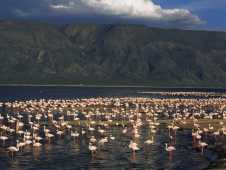
A Cost Benefit Analysis report shows that mining of soda ash at Lake Natron is not economically viable. Not only would it threaten the breeding habitat of the largest population of Lesser Flamingos in the world, it would also deliver far worse returns for local people. The report demonstrates that Lake Natron communities are better off without the soda ash plant and that investment should instead focus on protection of the environment and promotion of local livelihood alternatives (such as locally run ecotourism initiatives), as an opportunity for significant ‘win-wins’ for conserving important biodiversity and supporting livelihoods.
Lake Natron in Northern Tanzania is the most important breeding site for Lesser Flamingo Phoeniconaias minor in the world. There are between 1.5–2.5 million Lesser Flamingos in East Africa (over three-quarters of global population) and most are hatched at Lake Natron.
In 2006, Tata Chemicals Industries put forward a proposal to construct a soda ash plant at Lake Natron but withdrew in May 2008 following international concerns over negative impacts on flamingo breeding, local livelihoods and the environment. However, the Government of Tanzania, through the National Development Corporation, has maintained a keen interest in the proposal and so the Wildlife Conservation Society of Tanzania (BirdLife in Tanzania) contracted a consultant to undertake a cost-benefit analysis of the development of a soda ash plant at the lake.
The report, published in August 2012, confirms that mining of soda ash at Lake Natron is not economically viable. At the present levels of soda ash prices and investment costs, the benefits of ecosystem conservation outweigh the benefits of soda ash mining. The Cost Benefit Analysis shows that the projected return on investment over the next 50 years would be a loss of between $44 and $492 million, even if exempted from paying tax by the Government.
The soda ash plant would deliver far worse returns for local people. However, without the plant, the Tanzanian public and local communities stand to gain between $1.28 and $1.57 billion in 50 years, if the Government of Tanzania invests in tourism, protection of the environment and promotion of local livelihood alternatives. Compared to soda ash mining, the people and environment would still tap greater benefits even if the Government continued managing and investing in the environment at current levels.
The report also reveals that support for the soda ash mining proposal at Lake Natron is extremely low. Eighty four per cent of 175 local community respondents consulted during the study were strongly opposed to the soda ash plans while 10 per cent were in support. The rest were neutral.
Based on the results of this report, the Wildlife Conservation Society of Tanzania along with other NGOs is lobbying the Government of Tanzania to re-assess its long-standing interest to build a soda ash factory at Lake Natron.
Related Case Studies in other sections
Related Sites
Related Species
Compiled: 2012 Copyright: 2012
Recommended Citation:
BirdLife International (2012)
Cost-benefit analysis demonstrates that mining of soda ash at Lake Natron is not economically viable.
Downloaded from https://datazone.birdlife.org/cost-benefit-analysis-demonstrates-that-mining-of-soda-ash-at-lake-natron-is-not-economically-viable on 22/12/2024